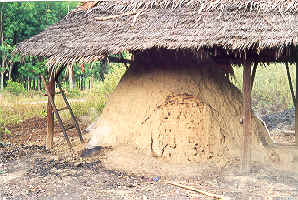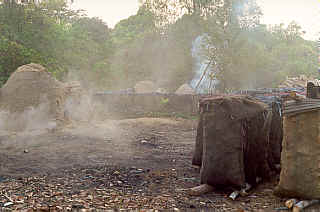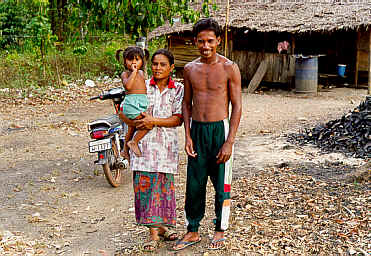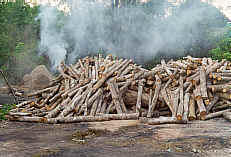
ON-LINE
Please E-mail us at:
Copyright�1998, The NESSThai
�
Network for Environmentally- & Socially-Sustainable Tourism (Thailand) |
Charcoal Burners� |
||
| All along the roads between Trang
town and the neighbouring province of Phattalung, there are small outfits of charcoal
producers. It is also common to see sacks of charcoal piled up beside the road next to
tracks leading into rubber plantations. Sometimes the charcoal makers are hidden behind
the trees, but there are plenty just off the side of the road. In the hazy afternoon
light, the smoke hangs low, filtering the sunlight through greys and blues. Charcoal making has a long tradition throughout Thailand. In the past, mangrove wood was used extensively in the South. The continuance of this practice is one of several threats to the mangroves. In Trang, there is an alternative source of wood more readily available and apparently capable of producing a higher quality charcoal: rubber. It seems sometimes that Trang is made on rubber. It is surprising how often one hears that this or that person made their first nest egg as a rubber planter, and the rubber plantations dominate the cultivated landscape. Old rubber trees, past their prime in latex production, are sold on for timber and charcoal. Khun Wichai�s boss buys the rubber trees and has them delivered to his charcoal-manufacturing site. Larger trees are sold for timber and the smaller trunks are left for charcoal. Rubber wood makes for a heavy charcoal that burns hot and long and leaves little ash. The residual latex in the wood adds value to the charcoal making it easier to light, and much of the charcoal made by Khun Wichai is exported out of the province to Bangkok. Khun Wichai and his wife, Rocharin, manage 17 charcoal pits for their boss. This is considerably higher than the norm of 7-8 pits. They are paid by the number of bags of charcoal they produce. They make about 60 bags a day and are paid about 20 Baht per bag. For most months their household makes well over 10,000 Baht (250 US dollars) - not a bad salary for a rural occupation in Thailand. However, it is a labour-intensive job and Khun Wichai commented that he gets tired managing all these charcoal pits, and carrying the rubber wood. Both Khun Wichai and his wife are Buddhist. Khun Wichai�s father is a fisherman, Rocharin�s parents have a market garden. They have two children, little Wiwan who is 2 � and Wiwat who is 11 years old. Wiwat, their son, goes to the school nearby. He is not a bad student and with his parents having a good income, he may well go on to study at secondary and perhaps tertiary level. His parents are not pushy in terms of a career, preferring to let their children do what they want with their lives. The process of charcoal making is similar to slow-firing in any kiln. The idea is to create a slow, relatively low temperature burn by limiting the amount of oxygen entering the charcoal kiln. In Thailand, charcoal is still a major fuel source for cooking in most rural and� some urban areas.
One of the 17 charchoal kilns
(written by Sophia Buranakul) |
All along the roads there are small outfits of charcoal producers |
|
|
||
Rubber wood makes excellent charcoal which lights quickly and burns hot and long |
||
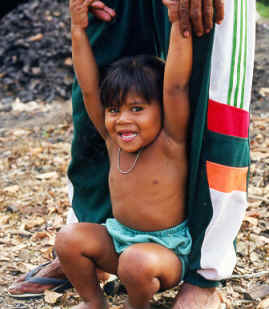 Little Wiwan, aged 2 and a half. |
||
![]()
E-mail us:




